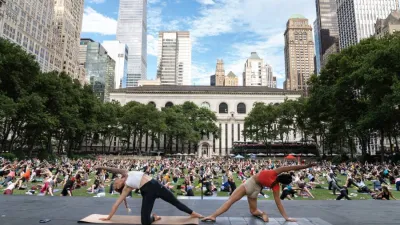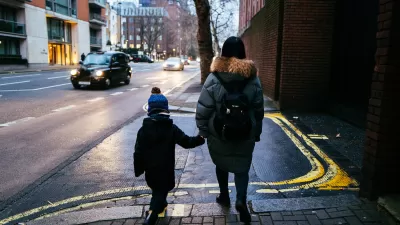As Britain confronts the silent epidemic of inactivity and obesity, Peter Walker examines how the invisible dangers of a sedentary lifestyle are compared to the more publicized risk of injury from activities designed to get people moving.
This week in Britain, the National Institute for Health and Clinical Excellence (Nice) released a stark report that finds, "almost two-thirds of men and nearly three-quarters of women in England are not sufficiently active to maintain their health, with the results little better for children," reports Walker. And as a solution to "a national epidemic of inactivity and obesity which now causes as much harm as smoking," the report's authors recommend that, "[w]alking and cycling should become the norm for short journeys rather than driving a car."
While the findings of the report are certainly dire, Walker seems equally astonished by one of the questions asked during the press conference in which the results and recommendations were announced. "One of the first was on cycle safety: had they taken into account the potential perils of riding a bike?" Some, it seems, are more fearful of the solution than the problem itself.
Walker quotes the answer to the question given by Dr Harry Rutter, lead author of the report and an adviser at the National Obesity Observatory: "All activities carry a risk...This focus on the dangers of cycling is something to do with the visibility of them, and the attention it's given. What we don't notice is that if you were to spend an hour a day riding a bike rather than being sedentary and driving a car there's a cost to that sedentary time. It's silent, it doesn't get noticed. What we're talking about here is shifting the balance from that invisible danger of sitting still towards the positive health benefits of cycling."
"People go on at exhaustive length about the perils of cycling because cycling remains niche," says Walker. "Sitting around on one's arse watching EastEnders and eating Pringles is, however, a national pursuit, and not enough people make the connection between that and an impact on health which is, the scientists told us, now on a par with that from smoking."
FULL STORY: Which really is more deadly: cycling or sitting down watching TV?

Planetizen Federal Action Tracker
A weekly monitor of how Trump’s orders and actions are impacting planners and planning in America.

Maui's Vacation Rental Debate Turns Ugly
Verbal attacks, misinformation campaigns and fistfights plague a high-stakes debate to convert thousands of vacation rentals into long-term housing.

San Francisco Suspends Traffic Calming Amidst Record Deaths
Citing “a challenging fiscal landscape,” the city will cease the program on the heels of 42 traffic deaths, including 24 pedestrians.

Amtrak Rolls Out New Orleans to Alabama “Mardi Gras” Train
The new service will operate morning and evening departures between Mobile and New Orleans.

The Subversive Car-Free Guide to Trump's Great American Road Trip
Car-free ways to access Chicagoland’s best tourist attractions.

San Antonio and Austin are Fusing Into one Massive Megaregion
The region spanning the two central Texas cities is growing fast, posing challenges for local infrastructure and water supplies.
Urban Design for Planners 1: Software Tools
This six-course series explores essential urban design concepts using open source software and equips planners with the tools they need to participate fully in the urban design process.
Planning for Universal Design
Learn the tools for implementing Universal Design in planning regulations.
Heyer Gruel & Associates PA
JM Goldson LLC
Custer County Colorado
City of Camden Redevelopment Agency
City of Astoria
Transportation Research & Education Center (TREC) at Portland State University
Jefferson Parish Government
Camden Redevelopment Agency
City of Claremont




























